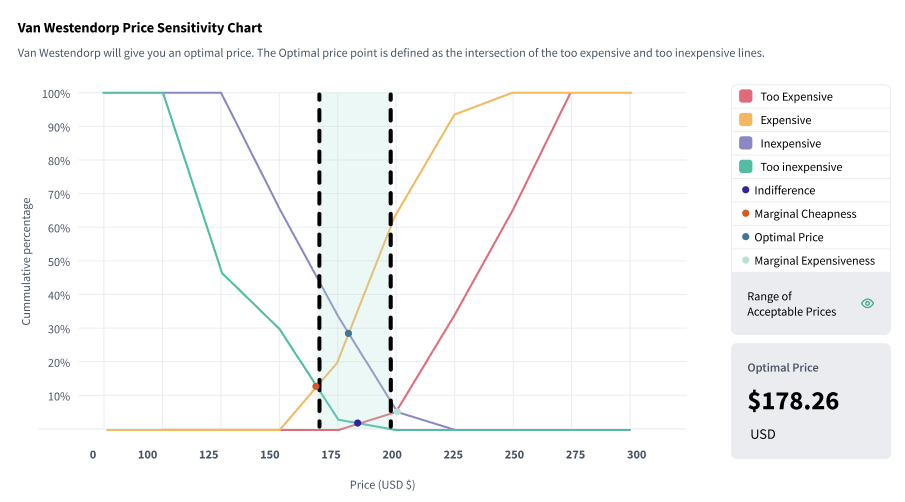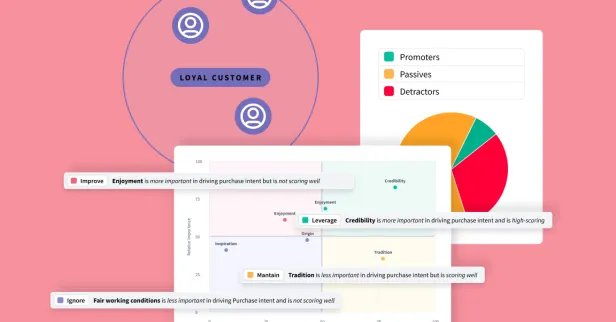Determining the optimal price for your products or services is a delicate balance. If you price your products too high, you risk alienating potential customers. But if your price is too low, you may undervalue your product.
Pricing research is a critical tool that provides businesses with the insights needed to set prices that maximize profitability while meeting customer expectations.
Today, we'll investigate multiple pricing research methods, when to use them, and how to conduct effective pricing research to ensure your business can confidently navigate the complexities of pricing strategy.
What is Pricing Research & Why do Businesses Use it?
Pricing research involves systematically collecting and analyzing data to understand how customers perceive price and how it impacts their purchasing decisions. It encompasses a range of methodologies designed to assess different facets of pricing, from customer price sensitivity to competitive pricing landscapes.
Businesses use pricing research for several key reasons:
![]() Determining the Best Pricing Strategy: By understanding customer price perceptions and behaviors, businesses can set prices that attract and retain customers while optimizing profit margins.
Determining the Best Pricing Strategy: By understanding customer price perceptions and behaviors, businesses can set prices that attract and retain customers while optimizing profit margins.![]() Identifying Customer Price Sensitivity: Knowing how sensitive customers are to price changes helps businesses predict the impact of price adjustments on sales volume and revenue.
Identifying Customer Price Sensitivity: Knowing how sensitive customers are to price changes helps businesses predict the impact of price adjustments on sales volume and revenue.![]() Forecasting Demand at Different Price Points: Pricing research can reveal how demand varies with price, aiding in setting prices that maximize sales.
Forecasting Demand at Different Price Points: Pricing research can reveal how demand varies with price, aiding in setting prices that maximize sales.![]() Optimizing Pricing for New Products: Introducing a new product involves setting an initial price that appeals to early adopters and gains market traction.
Optimizing Pricing for New Products: Introducing a new product involves setting an initial price that appeals to early adopters and gains market traction.![]() Staying Competitive in the Market: Regular pricing research helps businesses remain competitive by helping them understand how their pricing compares to that of competitors and adjust accordingly.
Staying Competitive in the Market: Regular pricing research helps businesses remain competitive by helping them understand how their pricing compares to that of competitors and adjust accordingly.
By leveraging pricing research, businesses can make informed decisions that enhance their market position and financial performance.
Pricing Research Methods
Price Sensitivity Testing (Van Westendorp)
Price sensitivity testing, also known as the Van Westendorp Price Sensitivity Meter, is a method used to understand how customers perceive the value of a product relative to its price. This method involves asking respondents a series of questions to gauge their perceptions of price, including:
- At what price do you consider the product to be too expensive?
- At what price do you consider the product to be too cheap?
- At what price do you consider the product to be a good deal?
- At what price do you consider the product to be expensive but worth it?
The answers to these questions help identify an acceptable price range and the optimal price point for a product.
When to Use Price Sensitivity Testing
Use Price Sensitivity Testing when you need to gauge acceptable price ranges for a new product or when re-evaluating the pricing of an existing product. This method is particularly useful when:
![]() Launching a new product and needing to set an initial price
Launching a new product and needing to set an initial price![]() Adjusting the price of an existing product in response to market changes
Adjusting the price of an existing product in response to market changes![]() Understanding consumer perceptions of price in a competitive market
Understanding consumer perceptions of price in a competitive market
Below is a sample from a Price Sensitivity Test on the SighrX platform, the visualization shows the acceptable range of prices highlighted in green

Price Demand Forecasting (Gabor-Granger)
The Gabor-Granger technique assesses the relationship between price and demand by presenting respondents with different price points and measuring their purchase intent. Respondents are asked how likely they are to purchase a product at various price levels, allowing businesses to estimate demand curves and identify optimal pricing strategies.
When to Use Price Demand Forecasting
This method is useful when forecasting demand at various price levels. It's particularly effective for products with multiple price points and when introducing new product variants. Use Price Demand Forecasting when:
![]() Evaluating different pricing strategies for a product
Evaluating different pricing strategies for a product![]() Understanding how price changes might impact sales volume
Understanding how price changes might impact sales volume![]() Planning promotions or discounts and needing to estimate their effect on demand
Planning promotions or discounts and needing to estimate their effect on demand
Conjoint Analysis
Conjoint Analysis helps determine how customers value different product attributes and how price changes impact their purchasing decisions. This method involves presenting respondents with various product configurations that include different features and prices and then analyzing their preferences to understand the trade-offs they make.
When to Use Conjoint Analysis for Pricing
Use Conjoint Analysis when you need to understand the trade-offs customers make between price and other product features. This method is particularly useful for:
![]() Complex products with several attributes that impact customer decision-making
Complex products with several attributes that impact customer decision-making![]() Identifying which product features are most valued by customers
Identifying which product features are most valued by customers![]() Developing new products and needing to understand how different features and price points affect customer preferences
Developing new products and needing to understand how different features and price points affect customer preferences
Price Rating
Price rating involves asking customers how reasonably they find different prices for a product or service. This straightforward approach provides direct feedback on perceived price fairness and can be used to gauge initial customer reactions to pricing.
When to Use Price Rating
Employ Price Rating when you want straightforward feedback on perceived price fairness. This method is best for:
![]() Products with a clear value proposition and less complexity
Products with a clear value proposition and less complexity![]() Quickly assessing customer perceptions of new prices
Quickly assessing customer perceptions of new prices![]() Situations where rapid feedback is needed to make pricing decisions
Situations where rapid feedback is needed to make pricing decisions
Brand Price Trade-Off
Brand Price Trade-Off examines how customers' price sensitivity changes when different brands offer similar products. This method helps businesses understand the impact of brand perception on pricing and how customers weigh brand against price.
When to Use Brand Price Trade-Off
Use this method when you need to understand the competitive landscape and how brand perception affects price sensitivity. It's particularly useful in markets with strong brand loyalty and when:
![]() Competing against well-established brands
Competing against well-established brands![]() Determining how much of a premium customers are willing to pay for a brand
Determining how much of a premium customers are willing to pay for a brand![]() Evaluating the impact of brand strength on pricing strategies
Evaluating the impact of brand strength on pricing strategies
How to Conduct Pricing Research
Set Goals for Your Research
Defining clear goals is the first step in conducting effective pricing research. Your goals should reflect what you want to achieve with your research, such as:
- Optimizing the price for a new product launch
- Understanding price sensitivity among different customer segments
- Comparing your pricing strategy to competitors
Clear goals help guide the research process and ensure that the insights you gain are aligned with your business objectives.
Identify the Audience for Testing
Determine who your target audience is for the pricing research. This involves identifying the specific customer segments you want to study, including demographic information, buying behavior, and preferences. A well-defined audience ensures that your research is relevant and that the insights you gather accurately reflect the perspectives of your target customers.
Choose a Research Method
Select the pricing research method that aligns with your goals and the nature of your product or service. Consider the strengths and limitations of each technique, and choose the one that best suits your needs. For example, Conjoint Analysis may be the best fit if you're launching a complex product with multiple features. If you're looking for straightforward feedback on pricing, Price Rating might be more appropriate.
Run Your Study and Collect Data
Conduct your pricing research study using surveys, interviews, or other data collection methods. Utilize market research platforms to streamline the process of gathering and managing your data. These platforms offer tools for designing surveys, targeting specific audiences, and generating reports, making it easier to conduct comprehensive pricing research. Collecting high-quality data is essential for obtaining accurate and actionable insights.
Analyze the Results and Pick Out Key Takeaways to Apply
Examine the data to uncover insights about price sensitivity, demand at different price points, and customer preferences. Use statistical analysis techniques to identify trends and patterns in the data. Focus on key takeaways that can inform your pricing strategy and help you make data-driven decisions. This might include identifying the optimal price point, understanding how different price levels affect demand, or uncovering the most valued product features.
Luckily, automated market research platforms with robust methodologies can significantly enhance the efficiency and accuracy of your pricing research. These platforms provide comprehensive survey design, data collection, and analysis tools. They enable you to reach a broad and targeted audience, ensuring your research data is robust and representative. By leveraging these platforms, you can streamline the research process, reduce the time and resources needed, and gain deeper insights into your pricing strategies.
Conduct Your Own Pricing Research with SightX
We understand that effective research is essential for making informed pricing decisions that align with market expectations and business goals. With SightX, you get access to powerful pricing research methodologies that help you drive growth and profitability.
By infusing the power of generative AI with advanced pricing research tools, SightX makes collecting pricing insights a breeze.
![]() Create fully customized surveys, studies, and experiments with a prompt.
Create fully customized surveys, studies, and experiments with a prompt.![]() Collect data from your target audience.
Collect data from your target audience.![]() Receive fully analyzed and summarized results in seconds, revealing key insights and personalized recommendations.
Receive fully analyzed and summarized results in seconds, revealing key insights and personalized recommendations.
Whether your need to test your market's price sensitivity or need to pinpoint your product's ideal price point, SightX offers a comprehensive suite of features designed to streamline the pricing research process and deliver tangible results.
Let us show you how simple it can be to collect powerful insights.
